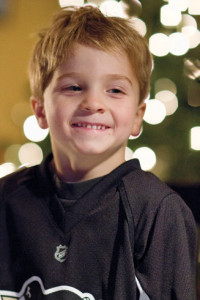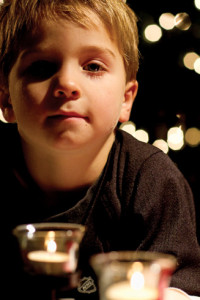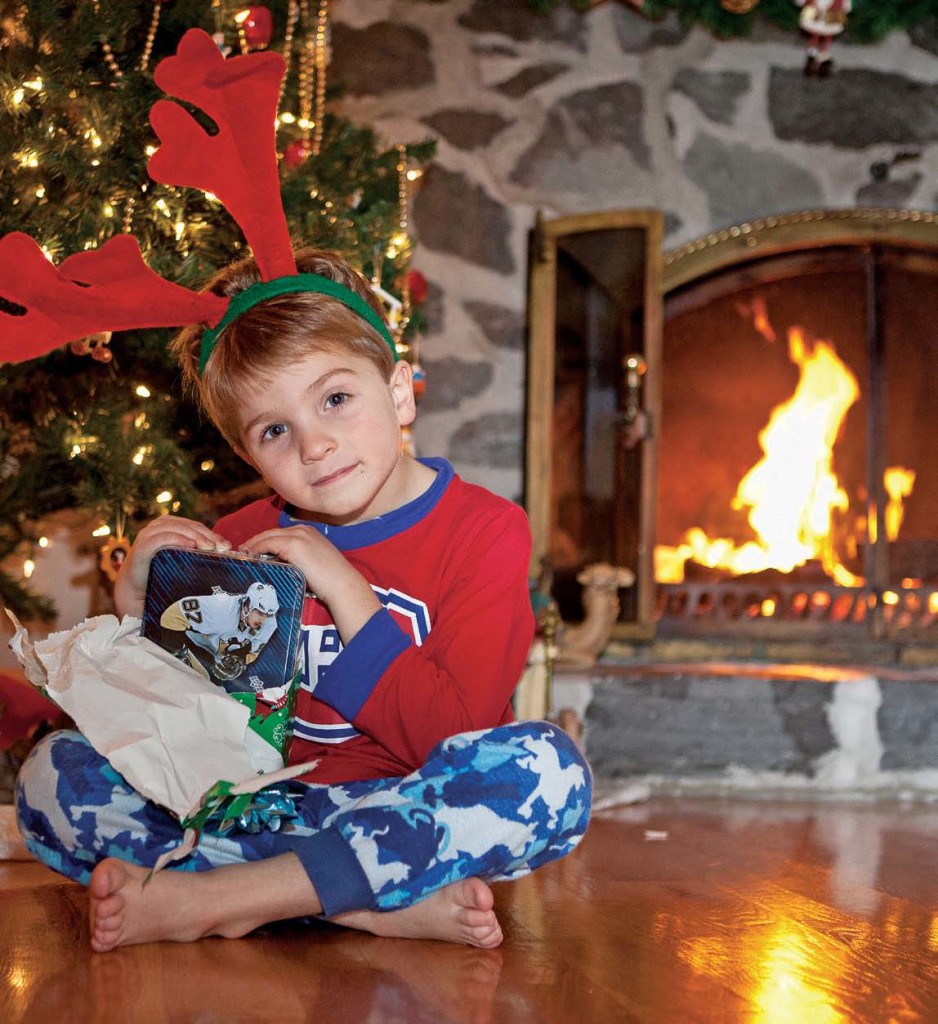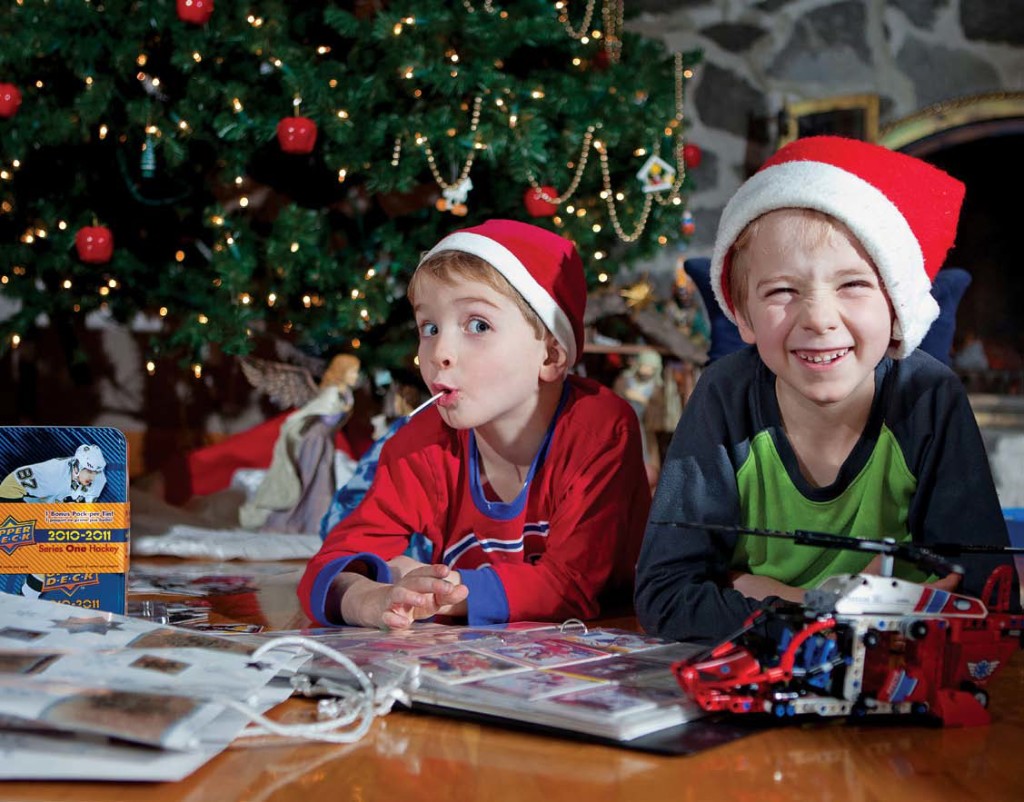With the holiday season just around the corner, it is an ideal time to take a look at a few techniques to create better family photos with a minimal investment in time and equipment.
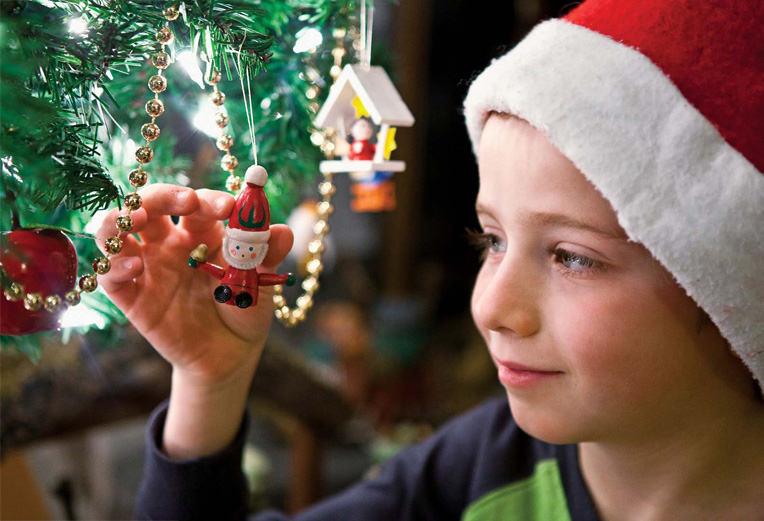
An ambient light image shot at high ISO setting, slow shutter speed, to allow the use of a very wide aperture for shallow depth of field. Canon EOS 5D Mark II, 62 mm, f/2.8 at 1/15″ (+1.33 EV), ISO speed rating: 2000/34°. Aperture priority. Metering Mode: Pattern. White Balance: Auto.
In an era of “auto-everything” digital cameras, many photo enthusiasts rely on the technology of modern sensors to capture high ISO images in low-light situations. While this may be fine in a pinch, and appropriate for certain subjects, there are some occasions that require a bit more effort to produce images of higher quality – the opportunity to take informal portraits of friends and family should not be lost in the dim light of your living room, when just a bit of effort can transform the snapshot into a visual treasure.
When Michel Roy showed me the photos he took for his family’s Christmas card, I reflected on some of the questions my friends have asked about shooting family photos during the holiday season. We decided to share a few basic tips to help PHOTO News readers capture the essence of holiday lighting.
In the average home, your light sources tend to be tungsten, quartz and compact fluorescent bulbs in fixtures that cast light in an uneven pattern throughout the room. The first challenge is to select the white balance setting that will produce the best skin tones in this mixed light situation. Consult your camera manual to learn how to tweak the manual white balance setting for indoor photography, and test a range of settings before you attempt to take once-in-a-lifetime photos – and don’t forget to return the settings to their basic positions after your indoor photo session is over!
The second challenge of ambient light photography is to manage the light to reduce the shadows around the subject’s eyes, and under the nose and chin. You might try using a white reflector below the subject’s face to bounce a bit of light into the shadows… the results will be a bit better, but in most cases you have to add a bit more light to capture the lasting memories that the family will treasure for generations to come.
Most of the DSLR cameras in use today have an on-board “pop-up” flash, which has some value in an indoor portrait situation, but the harsh direct light is less than flattering, and the intensity of the flash falls off very rapidly between your subject and the background. The close proximity of the flash tube to the optical axis of the lens can cause “red-eye” that can turn the face of an angel into something from Dante’s Inferno, and if you use a long lens, or a lens with a hood, it may cast a shadow on your scene.
You can improve your family photos dramatically by using a shoe mount flash. For my own shots, I use a Metz 58AF-2 flash that delivers all of the manual and dedicated automatic functions available with my camera system, with a few additional features that I find particularly useful. The Metz flashes are available in models that are fully compatible with all of the current DSLR systems.
When you slide the flash into your camera’s hot shoe, the additional distance between the flash tube and the lens axis will eliminate the problem of “red-eye”, but a direct burst of light will still wash out the foreground and leave the background dark. If your flash has a movable head, you can bounce the light off a white ceiling to spreadthe light throughout the room. If the flash head swivels as well as tilting, you can also bounce light off the ceiling with the camera in the “portrait” orientation. This is a major advantage, and it easily justifies the cost of the mid range and top-of-the-line models. The Metz 58 AF-2 flash that I use has a small reflector card that pulls up to direct some of the light toward the subject when the flash head is aimed at the ceiling. You can also activate the secondary flash tube on the front of the flash to achieve both direct and bounce lighting… this is an improvement over a single tube flash, and a feature that I find extremely valuable for my personal photo adventures. The mid-range Metz 50AF-1 flash packs almost as much power as the 58 AF-2, but it does not have the secondary flash tube – I often use this as a second flash in a wireless multiple flash set-up.
You can improve your home portrait results dramatically by adjusting the flash sync shutter speed, the sensor ISO setting, and lens aperture to let the flash mix with the ambient light to produce a more pleasing result. This technique is often referred to as “dragging the shutter” – essentially slowing down the shutter to allow the room light to register on the sensor – without slowing down the shutter, the camera will fire at 1/60 second or faster, and the flash will overpower the ambient light. In most cases, you will want to shoot portraits at f/5.6 or f/8 to have the desired depth of focus for a sharp image. You can shoot at wider apertures to separate subject from background –remember to always focus on your subject’s eyes.
It is a good idea to use a tripod whenever practical for interior photos of the family, for two reasons – first, when shooting at slow shutter speeds, it is difficult to hand-hold the camera without having some degree of camera shake. Second, it is much more convenient to use a tripod to hold the camera while you pose the subjects for a series of photos – you can also use a remote shutter release or a self-timer, and be part of the picture.
The best perspective for family photos is to shoot from the subject’s eye level. For the photos showing the children sitting at the base of the Christmas tree, Michel got down on the floor to see the world from the children’s eye level.
Beyond Basic Flash
For family photos, you can diffuse the harsh light of your flash and get excellent results by using a LumiQuest QuikBounce – this device fits in your pocket, and installs in seconds on your flash to provide a versatile choice of light management tools. With the top doors closed, you see a lighting effect similar to a traditional “ceiling bounce”. With the top doors open, 80% of the flash output will be bounced off the ceiling, and 20% will be “front fill” softened and aimed at a more direct angle, adding catch light to the eyes and opening the shadows on your subject’s face.
The LumiQuest QuikBounce is ideal for a portrait of one or two people. For larger groups, a larger reflective surface is desirable, and that can be provided by the LumiQuest BigBounce. When you consider the low price of these light management devices, and the seconds that it takes to transform your basic snapshot rig into a much more efficient tool for mastering light, you won’t wait for the holidays to buy yourself a present that will enhance your photo skills for years to come. If you practice with the various lighting setups, and make notes so that you can remember the settings and placement of the flashes, you will be able to repeat a successful lighting arrangement in a matter of minutes.
Moving up from the “snapshot class” to a more sophisticated approach to portrait lighting is remarkably easy – it could be the fastest and least expensive way to change the reactions from your friends and family from “do we know that person?” to “WOW – what a great picture”.
Article by Norm Rosen
Photos by Michel Roy
Read our follow up article – Changing Your Settings… “Ambient Light”



